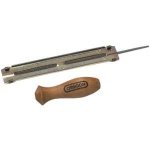I’d like the see all of these hand file users line up their hand filed saws against the same saw with a new factory chain. I’m sure someone is going to say they they can sharpen not only that good but better. Well some people can bench 500 pounds but the average Joe can’t. I’ve watched a lot of people chainsaw and the vast majority of the hand filers are running dull saws. I would bet money that the number of users that could hand file a saw and make it cut good without a guide is in the single digit percentage.
Perhaps we should clarify our terms a bit. When I say "hand file", I mean I am not using a grinder. This could be filing using a gauge or guide or it could be using just a bare file and nothing else. I call that latter "free-hand filing" - using a file with no other guide.
I've said it on here before, but I've met easily more than a hundred people who
think they do a great job free-hand filing. I've met just three who actually
can do as good or better than a factory new chains when using nothing but a round file. (One was a pro logger, one was a retired machinist. I forget what background the other had). Sadly, I am not one of those people. Frankly, I've not seen any need to develop the free-hand skill. With a decent guide, and a moderate amount of practice, it's not hard to improve on a factory new chain, and get a chain that cuts smoothly and consistently
What some fail to realize is that there is more to sharpening a chain well than just making it more aggressive. I don't want to be fighting the saw all day. Also, cutting a bit faster doesn't do any good if the geometry of the chain is such that it won't hold up well. (this is especially especially noticeable when cutting the slow-grown hardwoods in our area.)
The two types of sharpening guides I've had good luck with (fast, easy to use, and get reliably good results):
-

Oregon_File_holder.jpg
4.3 KB
· Views: 399
-

Roller file guide.JPG
31.7 KB
· Views: 418
I've also used the Pferd Chainsharp CSX and the Stihl 2 in 1 (which is just a relabeled Pferd guide). They have an advantage that they are faster, since they set the depth gauge at the same time you are sharpening. The disadvantage is that their method of setting the depth guages is not progressive, requiring that you match the lengths of the cutters when sharpening for best performance. Contrary to popular belief, it is
not necessary to match the length of the cutters if you use a progressive tool for setting the depth gauges. (but that's a subject for another post - one which I have already made here on TBN several times).


